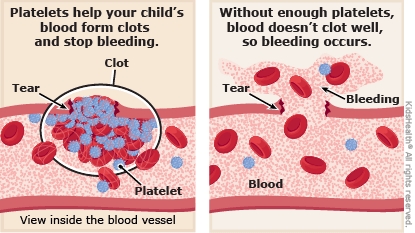Platelets help the blood clot and stop bleeding. When someone has low platelets, it's called thrombocytopenia (pronounced throm-buh-sye-tuh-PEE-nee-uh).
If the platelet count is just a little low, someone may not have any symptoms. As it drops a little more, someone may have easy bleeding (for example nosebleeds or bleeding gums), easy bruising, or red spots on the skin. As the platelets go lower, more serious symptoms can happen like bleeding into the stomach, bowel, urinary (pee) tract, or brain.
Treatment usually includes making changes to lower the risk of bleeding, medicines, and sometimes a platelet transfusion (platelets given through an intravenous (IV) line).

Follow your health care provider's advice for:
- Giving your child any medicines.
- Going for platelet transfusions.
- Whether your child needs to go for any other testing.
- Any medicines to avoid, such as nonsteroidal anti-inflammatory drugs (NSAIDs) like ibuprofen (Advil®, Motrin®, or a store brand), naproxen (Aleve®, Naprosyn®, or a store brand), and aspirin. All of these can increase bleeding.
- What to do if your child is bleeding. Some kids with very low platelets need to go to the emergency room (ER) even for small cuts and nosebleeds.
- Following up with a hematologist (doctor that specializes in problems with the blood).
- When your child should follow up.
To prevent bleeding:
Your child should:
- Avoid contact sports, trampolines, and bounce houses.
- Always wear a helmet when riding a bike or scooter, skiing, and doing other activities where they could fall and hit their head.
- Use a soft-bristled toothbrush.
- Not use dental floss, or use it gently and stop if there is any gum bleeding.
- Use an electric shaver instead of a razor if old enough to shave.
- Avoid using sharp knives, scissors, and needles.
- Avoid being given any medicine rectally (in the bottom) or having their temperature taken rectally, as this can cause bleeding.
If your health care provider says you can treat bleeding at home:
- For small cuts that are bleeding a little, rinse the cut with water and apply pressure with sterile gauze, a bandage, or a clean cloth.
- If the cut is bleeding a lot, apply pressure with sterile gauze, a bandage, or a clean cloth. Raise the injured body part to slow bleeding, and call your health care provider.
- For nosebleeds, pinch the soft part of the nostrils together and have your child lean slightly forward to keep blood from going down the throat.
Other things to remember:
- Be sure your child's dentist and other health care providers know about your child's condition.
- If your child is going to have any dental or surgical procedures, be sure you check with your child's hematologist first.
- If your child has heavy periods, birth control pills or an IUD (intrauterine device) can sometimes decrease the bleeding.

What causes low platelets? Kids can develop low platelets from:
- Viral infections
- Autoimmune problems (where the immune system destroys platelets)
- Not enough platelets being created by the bone marrow (the spongy material inside bones that makes platelets and other blood products)
- Medicines, including chemotherapy
- Inherited (genetic) problems
- Blood cancer (leukemia)
- Other health conditions that destroy platelets or use them up too quickly
What tests do children with low platelets need? It depends on what is causing their low platelets and their symptoms. Most kids will need blood tests to check their platelet count and other parts of the blood. Some kids will also need a bone marrow biopsy. For this test, the doctor puts a needle into the bone and takes out a small amount of bone marrow. Then, doctors look at the bone marrow under a microscope to look for problems.




